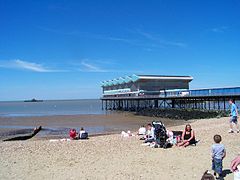Herne Bay, Kent
| Herne Bay | |
|---|---|
 Herne Bay |
|
| Herne Bay shown within Kent | |
| Area | 10.79 km2 (4.17 sq mi) |
| Population | 38,563 (2011 Census) |
| • Density | 3,574/km2 (9,260/sq mi) |
| OS grid reference | TR177681 |
| • London | 67mi |
| District | |
| Shire county | |
| Region | |
| Country | England |
| Sovereign state | United Kingdom |
| Post town | HERNE BAY |
| Postcode district | CT6 |
| Dialling code | 01227 |
| Police | Kent |
| Fire | Kent |
| Ambulance | South East Coast |
| EU Parliament | South East England |
| UK Parliament | |
Herne Bay /hɜːrn/ is a seaside town in Kent, South East England, with a population of 38,563. On the south coast of the Thames Estuary it is 7 miles (11 km) north of Canterbury and 5 miles (8 km) east of Whitstable. It neighbours the ancient villages of Herne and Reculver and is part of the City of Canterbury local government district. Herne Bay's seafront is home to the world's first freestanding purpose-built Clock Tower, built in 1837; from the late Victorian period until 1978, the town had the second-longest pier in the United Kingdom.
The town began as a small shipping community, receiving goods and passengers from London en route to Canterbury and Dover. The town rose to prominence as a seaside resort during the early 19th century after the building of a pleasure pier and promenade by a group of London investors, and reached its heyday in the late Victorian era. Its popularity as a holiday destination has declined over the past decades, due to the increase in foreign travel and to a lesser degree exposure to flooding that has prevented the town's redevelopment.
The town of Herne Bay took its name from the neighbouring village of Herne, two kilometres inland from the bay. The word herne, meaning a place on a corner of land, evolved from the Old English hyrne, meaning corner. The village was first recorded in around 1100 as Hyrnan. The corner may relate to the sharp turn in the minor Roman road between Canterbury and Reculver at Herne.
...
Wikipedia

